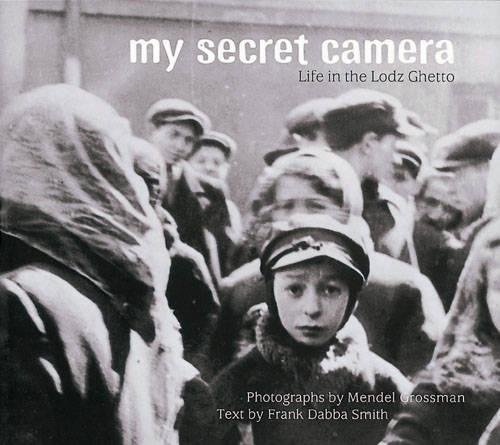-
My Secret Camera
Frank Dabba Smith, Mendel Grossman
Hardcover (Gulliver Books, April 1, 2000)In 1940 as Nazi troops rolled across Europe, countless Jewish families were forced from their homes into isolated ghettos, labor and concentration camps. In the Lodz Ghetto in Poland, Mendel Grossman refused to surrender to the suffering around him, secretly taking thousands of heartrending photographs documenting the hardship and the struggle for survival woven through the daily lives of the people imprisoned with him. Someday, he hoped, the world would learn the truth. My Secret Camera is his legacy. •An important historical record of life during the Holocaust •Features an introduction by Howard Jacobson, author of The Very Model of a Man and Roots Schmoots: Journeys Among Jews •Features 17 beautifully composed photographs W
W
-
My Secret Camera: Life in the Lodz Ghetto
Frank Dabba Smith, Mendel Grossman
Paperback (Frances Lincoln Children's Books, June 1, 2008)Mendel Grossman was a prisoner in Poland's Lodz Ghetto for more than four years. His job was to take photographs for work permits, but he also secretly used his camera to record the daily lives of his fellow Jewish residents. These images speak with devastating poignancy of cultural devastation but also of the indomitable spirit of these people. Unrivalled in historical importance and emotional impact, the pictures show grim tableaux of a child clutching a wire fence, soldiers marching through empty streets, crowds moving uneasily toward what is surely deportation. In contrast, there are also intimate scenes of workers smiling as they bake Passover matzoh, and teenagers sharing a private joke. Of the thousands of photographs taken by Grossman, only a small number survived: this book features 17 of the most resonant. Rabbi Frank Dabba Smith provides simple, heartfelt text in the voice of Mendel Grossman; it reminds readers not simply of the horrors of the time but also of the hope and courage that kept humanity going. An appendix tells the fascinating story of how these photographs survived. Q
Q
-
My Secret Camera : Life in the Lodz Ghetto
Mendel Grossman, Frank Dabba Smith, Howard Jacobson
Paperback (Frances Lincoln Ltd, June 30, 2003)None
-
My Secret Camera
Mendel Grossman, Frank Dabba Smith, Howard Jacobson
Hardcover (Frances Lincoln Publishers, March 1, 2000)Mendel Grossman, one of the many Jews imprisoned in the Lodz Ghetto during World War II, was driven by a passion to bear witness to the human suffering that was going on around him. He secretly photographed people and events in the ghetto, leaving a historical record. In this photographic information book, the reader is taken on a journey with Grossman and his camera. The text emphasizes hope for the future, rather than the suffering of the past.
-
My Secret Camera
Frank Dabba Smith
Library Binding (Raintree, Sept. 28, 1999)In 1940 as Nazi troops rolled across Europe, countless Jewish families were forced from their homes into isolated ghettos, labor and concentration camps. In the Lodz Ghetto in Poland, Mendel Grossman refused to surrender to the suffering around him, secretly taking thousands of heartrending photographs documenting the hardship and the struggle for survival woven through the daily lives of the people imprisoned with him. Someday, he hoped, the world would learn the truth. My Secret Camera is his legacy. An important historical record of life during the Holocaust Features an introduction by Howard Jacobson, author of The Very Model of a Man and Roots Schmoots: Journeys Among Jews Features 17 beautifully composed photographs W
W
-
My Secret Camera: Life in the Lodz Ghetto
Mendel Smith, Frank Dabba and Grossman
Hardcover (Gulliver Books, Aug. 16, 2000)Mendel Grossman was a prisoner in Poland's Lodz Ghetto for more than four years. His job was to take photographs for work permits, but he also secretly used his camera to record the daily lives of his fellow Jewish residents. These images speak with devastating poignancy of cultural devastation but also of the indomitable spirit of these people. Unrivalled in historical importance and emotional impact, the pictures show grim tableaux of a child clutching a wire fence, soldiers marching through empty streets, crowds moving uneasily toward what is surely deportation. In contrast, there are also intimate scenes of workers smiling as they bake Passover matzoh, and teenagers sharing a private joke. Of the thousands of photographs taken by Grossman, only a small number survived: this book features 17 of the most resonant. Rabbi Frank Dabba Smith provides simple, heartfelt text in the voice of Mendel Grossman; it reminds readers not simply of the horrors of the time but also of the hope and courage that kept humanity going. An appendix tells the fascinating story of how these photographs survived.